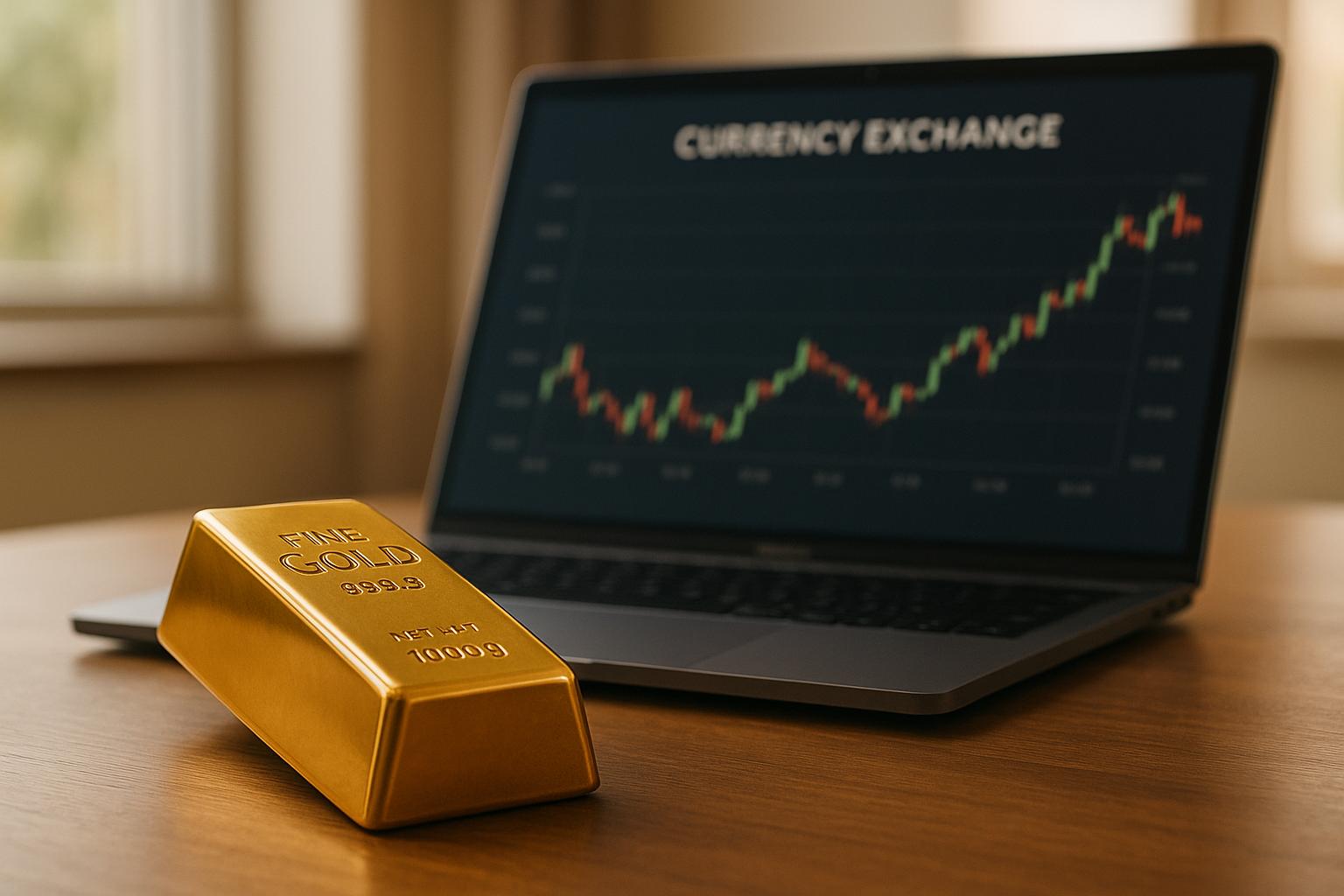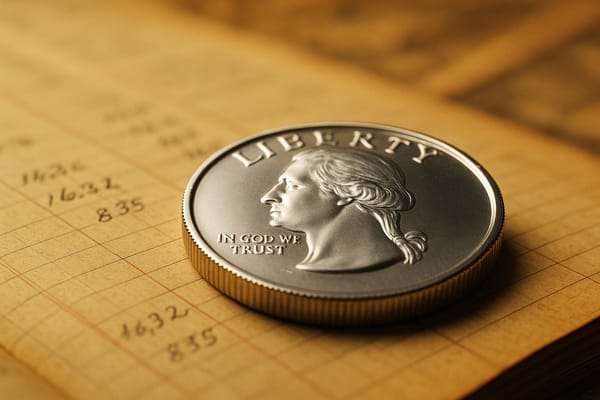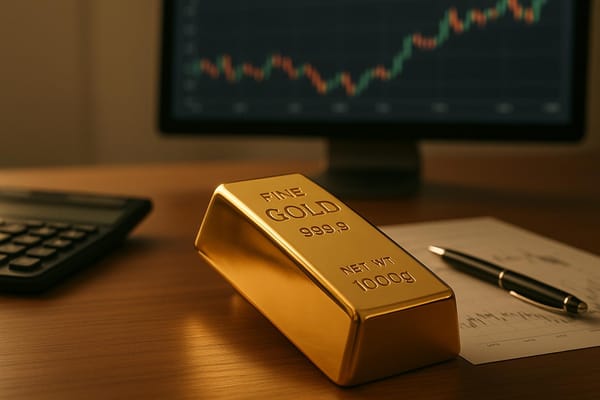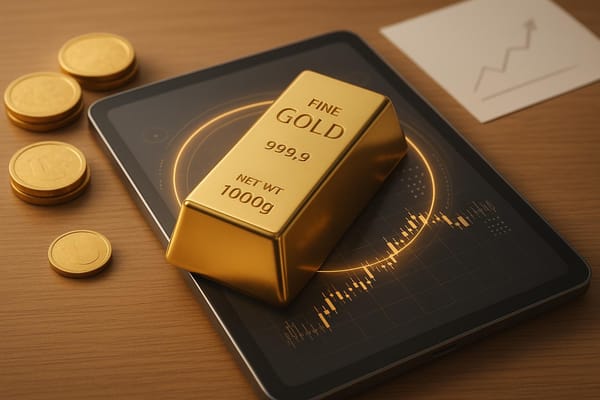Do Exchange Rates Affect Gold?
Explore how exchange rates influence gold prices, the impact of currencies, and strategies for investors navigating this dynamic market.

Exchange rates play a direct role in gold prices, especially since gold is priced in U.S. dollars globally. Here's how it works:
- Stronger Dollar, Lower Gold Prices: When the U.S. dollar strengthens, gold becomes more expensive for international buyers, reducing demand and often lowering prices.
- Weaker Dollar, Higher Gold Prices: A weaker dollar makes gold cheaper for buyers using other currencies, increasing demand and pushing prices higher.
- Historical Trends: Events like the 2008 financial crisis and Brexit show how currency shifts can drive gold demand and prices.
- Central Banks' Role: In 2025, central banks are buying large amounts of gold to reduce reliance on dollar reserves, further influencing prices.
Gold also acts as a hedge against currency risk, but its effectiveness depends on timing and market conditions. For U.S. investors, understanding the dollar's movements is key to maximizing returns on gold investments. Factors like interest rates, geopolitical events, and supply-demand dynamics also shape gold prices.
Gold Price Spikes As Tariff Turmoil Hits Bullion
How Currency Changes Affect Gold Prices
Currency fluctuations send ripples through global gold markets, shaping the decisions of both institutional and individual investors. Understanding these dynamics sheds light on why gold prices can shift even when broader market fundamentals appear steady.
What Happens When the U.S. Dollar Weakens
A weaker U.S. dollar often makes gold more appealing to international buyers. Since gold is priced in dollars, a decline in the dollar's value increases purchasing power for buyers using other currencies, driving up demand - and often, prices. Additionally, a weaker dollar can signal inflationary pressures, further enhancing gold's appeal as a hedge. For gold-mining companies operating outside the U.S., this dynamic can be beneficial. If their production costs are in local currencies but revenues are in dollars, they may see improved profit margins, though long-term production depends on other factors.
How Other Major Currencies Affect Gold
While gold is primarily traded in U.S. dollars, shifts in other major currencies also play a role in shaping demand and influencing global prices. For instance, European investors often gravitate toward gold during periods of economic or monetary uncertainty. In Japan, a weaker yen tends to increase interest in gold, while in China, changes in the yuan's value can impact both domestic gold demand and the competitiveness of gold exports.
In emerging markets, significant currency devaluations often prompt local investors to turn to gold as a safe store of value. When multiple major currencies weaken against the dollar simultaneously, these effects can compound, amplifying demand for gold on a global scale. Historical trends consistently highlight the influence of these currency movements.
Real Examples of Exchange Rate Effects
Historical events provide clear examples of how currency fluctuations impact gold prices. During the 2008 financial crisis, the U.S. dollar initially strengthened but later softened as monetary policy became more accommodative. This shift coincided with a sharp rise in gold prices, driven by concerns over currency devaluation.
A similar pattern emerged after the Brexit referendum in 2016. The British pound plummeted against the dollar, leading to a notable increase in gold prices when measured in pounds.
More recently, during the Turkish lira crisis in the early 2020s, gold prices in lira terms surged as the currency weakened dramatically, even though gold prices in dollars remained relatively stable. In Canada, fluctuations in the Canadian dollar also directly affect local gold prices, with a weaker currency driving up costs for Canadian buyers.
These examples highlight the critical role of currency movements in shaping gold's performance and underscore why they are essential to consider when evaluating gold as an investment.
Gold as Protection Against Currency Risk
When Gold Doesn't Protect Against Currency Risk
Gold is often seen as a safeguard against currency risk, but it doesn't always offer complete protection, especially in the short term. If a local currency depreciates, the rise in gold prices in that currency may not fully offset the losses from exchange rate fluctuations. This can limit gold's ability to act as a reliable hedge.
This limitation underscores the importance of assessing gold's role within a broader investment strategy. At Gold and Silver.net, we emphasize these subtleties to help investors make informed decisions in today’s interconnected financial landscape.
Other Factors That Move Gold Prices
Gold prices are influenced by more than just exchange rates. Factors like interest rates, supply-demand dynamics, and global events play a significant role in shaping the market. Understanding these elements gives investors a broader perspective on what drives gold prices beyond currency fluctuations.
How Interest Rates and Central Bank Policies Affect Gold
Interest rates have a direct impact on gold's appeal. When rates rise, bonds and savings accounts offer better returns, making gold - a non-yielding asset - less attractive. On the other hand, when the Federal Reserve cuts rates, the dollar often weakens, which can push gold prices higher. Conversely, rate hikes tend to strengthen the dollar and put downward pressure on gold.
Central bank policies like quantitative easing also influence gold. When central banks increase the money supply, concerns about currency devaluation often lead investors to seek refuge in gold. Additionally, when major central banks purchase gold, it can boost demand and support prices, adding another layer of complexity to the market.
Supply and Demand Forces in Gold Markets
Gold mining lays the foundation for supply, but it’s relatively inflexible in the short term. This means that sudden spikes in demand can’t be quickly matched by increased production.
Several factors shape gold’s supply and consumption. Key producers like China, Australia, and Russia impact supply through their mining outputs and export policies. On the demand side, jewelry remains a major driver, particularly in countries like India and China, where gold holds cultural and economic significance.
Beyond jewelry, industrial and technological uses also sustain demand. Gold is a critical component in electronics, medical devices, and other applications. Investment demand, such as gold ETFs, coins, and bars, can lead to sharp price swings, especially during times of economic uncertainty when investors turn to gold as a safe haven.
How Global Events Drive Gold Prices Higher
Global events often send gold prices soaring, as investors seek safety during uncertain times. Geopolitical tensions, such as conflicts or political instability, make gold particularly appealing because it remains unaffected by direct political influences. These situations frequently result in demand spikes as people look for stable assets.
Economic crises are another trigger for rising gold demand. Whether it’s a banking collapse, a stock market downturn, or fears of a recession, gold often benefits as investors move away from riskier assets. Inflation concerns also make gold attractive, as it has a long history of preserving purchasing power. When rising prices erode the value of cash and bonds, gold becomes a preferred store of value.
These factors don’t operate in isolation. Often, movements in exchange rates, interest rates, geopolitical events, and supply-demand dynamics interact, creating the complex patterns seen in gold pricing. Together, they form a multifaceted landscape that goes well beyond exchange rate influences, offering a richer understanding of the forces shaping gold markets.
Key Points for U.S. Gold Investors
For American investors, understanding how exchange rates influence gold prices is crucial for making informed decisions about adding precious metals to their portfolios. The interplay between the U.S. dollar and gold creates both opportunities and challenges, requiring thoughtful strategy.
How Currency Changes Affect Your Gold Investment
Investing in gold as a U.S. investor often means betting against the dollar. When the dollar weakens, gold prices tend to rise, boosting returns. On the flip side, a stronger dollar usually pushes gold prices down. This inverse relationship means that even without other market changes, a weaker dollar can increase the value of your gold holdings.
Timing is key when buying gold. Purchasing gold while the dollar is strong often provides a more favorable entry point. Conversely, buying during periods of dollar weakness might mean paying a premium.
Currency fluctuations also impact how gold performs compared to other investments in your portfolio. For instance, during times of dollar strength, domestic stocks and bonds may outperform gold. But when the dollar weakens, gold often delivers stronger returns, acting as a hedge against losses in other asset classes.
Tips for Managing Currency Risk in Gold Investing
- Keep an eye on the Dollar Index (DXY): This index measures the dollar's strength against a basket of major currencies. A rising DXY often signals headwinds for gold, while a declining DXY can indicate potential opportunities.
- Use dollar-cost averaging: Instead of making large, one-time gold purchases, consider spreading out your investments over time. This approach helps reduce the impact of short-term currency fluctuations, ensuring you don't buy all your gold at an unfavorable exchange rate.
- Diversify your gold investments: Explore different forms of gold investments, such as physical gold, gold ETFs, and gold mining stocks. Mining stocks, for instance, often benefit from a weaker dollar due to their international operations and costs in foreign currencies.
- Pay attention to Federal Reserve announcements and economic data: Key events like employment reports, inflation updates, and Federal Reserve meeting minutes can move the dollar significantly. Understanding these triggers can help you anticipate shifts in gold prices.
By managing currency risk effectively, you can make gold a more stable and reliable part of your portfolio.
Why Gold Still Matters in Modern Portfolios
Gold continues to play an essential role as a hedge against currency devaluation and economic uncertainty, even in today’s complex financial landscape. While portfolios now include a variety of sophisticated assets, gold remains a reliable safeguard against dollar weakness.
Gold offers protection against inflation and economic instability in ways other assets often cannot. When central banks increase the money supply, gold tends to hold its value better than cash or bonds, making it especially appealing during periods of high inflation or financial turmoil.
Another advantage is gold’s low correlation with stocks and bonds, which makes it a powerful diversification tool. When markets are under stress and traditional assets move in the same direction, gold often moves independently or inversely, helping to stabilize your portfolio.
Modern investors also benefit from a variety of ways to invest in gold. Whether through physical coins and bars, ETFs, or digital platforms, it’s easier than ever to adjust your gold allocation based on currency trends and economic conditions - without the logistical challenges of storing physical gold.
FAQs
How do changes in exchange rates affect the profitability of gold mining companies operating outside the U.S.?
Exchange rate swings can play a big role in shaping the profitability of gold mining companies operating outside the U.S. When a local currency weakens compared to the U.S. dollar, gold prices in that local currency often rise. This can lead to higher revenues for mining companies. But there's a catch - some countries enforce foreign exchange policies, like requiring currency conversions at fixed rates, which can limit these gains.
Currency fluctuations also impact operational costs. For example, if equipment or supplies are imported and priced in stronger currencies, expenses can climb. On top of that, these shifts can complicate the process of repatriating earnings, further influencing profitability. For mining companies, staying on top of exchange rate risks is crucial to keeping their financial performance steady.
How can U.S. investors reduce the impact of currency fluctuations when investing in gold?
U.S. investors looking to minimize the impact of currency swings on their gold investments have a few strategies at their disposal. One effective approach is diversifying their portfolios and utilizing tools like currency futures or options. These hedging techniques can help offset risks associated with potential dollar depreciation, particularly given the inverse relationship between the U.S. dollar and gold prices during volatile times.
Another practical route is investing in gold through gold ETFs. These funds, traded in U.S. dollars, track gold prices in USD, making them less vulnerable to fluctuations in exchange rates. By blending these methods, investors can more effectively navigate the challenges of currency movements while maintaining greater stability in their gold-related assets.
How do global events and currency changes impact gold prices?
Global events and geopolitical tensions often push investors toward gold, viewing it as a safe-haven asset during uncertain times. Such events can erode the strength of major currencies, including the US dollar. Since gold and the dollar generally have an inverse relationship, a weaker dollar often results in higher gold prices.
Currency instability and geopolitical crises play a significant role in influencing gold's value. When currencies depreciate or markets face turmoil, gold becomes a dependable option for safeguarding wealth, offering a hedge against these financial risks.



